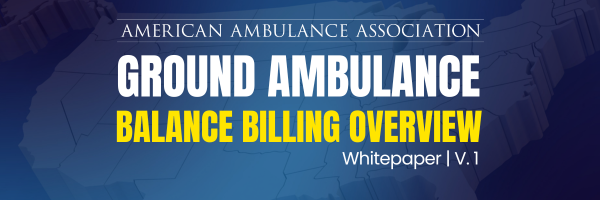
Ground Ambulance Balance Billing Overview

December 2024 | Version 1
Executive Summary
The practice of balance billing occurs when providers charge consumers the remaining costs of a healthcare service that was not covered by insurance, often due to being out-of-network.1 Although this practice occurs with many provider types, balance billing occurs quite frequently in emergency situations, such as when ground ambulance providers are involved. Consumers often face unexpected bills due to their inability to choose in-network providers during emergencies, leading to financial strain and difficult healthcare decisions. In addition to consumers being placed in the middle of the billing dispute, providers are also in an untenable position where they have rendered a service and are unable to receive the full payment. Payers, ultimately, want to be able to predict and control healthcare costs for members, and the current regulatory framework around payment for ground ambulance services does not permit that. In short, balance billing and the regulatory framework that permits balance billing hurt consumers, providers, and payers. As a result, it is incumbent upon state and federal policy-makers to adopt solutions that can benefit all three of these groups and alleviate what is essentially a no-win scenario for consumers, providers, and payers.
Federal and state laws have evolved to protect consumers from balance billing. The recent No Surprises Act (NSA) provided significant protection to consumers but notably excluded ground ambulance services. As a result, the Ground Ambulance and Patient Billing Advisory Committee (GAPB) was asked to convene and provide recommendations on how to include ground ambulances in federal legisla-tion. The Committee released its recommendations in the summer of 2024 with the caveat that all recommendations needed to be taken together and not be added to the current NSA without the modifications addressed in the recommendations. The twelve recommendations address how to move forward with the NSA framework, standardizing certain definitions, protections for consumers, and health plan and provider reimbursement.
At the local level, states have enacted their own patchwork of legislation to protect consumers from balance billing, sometimes including or excluding ground ambulance, and provide reimbursement guidance for providers utilizing various reimbursement methodologies such as local rates and Medicare percentages. There are opportunities for states that have not yet enacted balance billing protections to learn from promising practices, which we outline in this paper.
Future federal and state legislation is needed to remove consumers from billing disputes, standardize payment methodologies while deferring to local rates, and include all ground ambulance services to ensure comprehensive protections.
The full whitepaper provides an in-depth analysis of ground ambulance balance billing by focusing on the historical and current legislative landscape and offering recommendations for future policies at the federal and state levels to protect consumers and ensure fair reimbursement for providers. Because balance billing is a problem negatively impacting consumers, providers, and payers, the solutions we discuss below have potential to benefit all three groups and bring additional stability and predictability to the delivery of ground ambulance services.